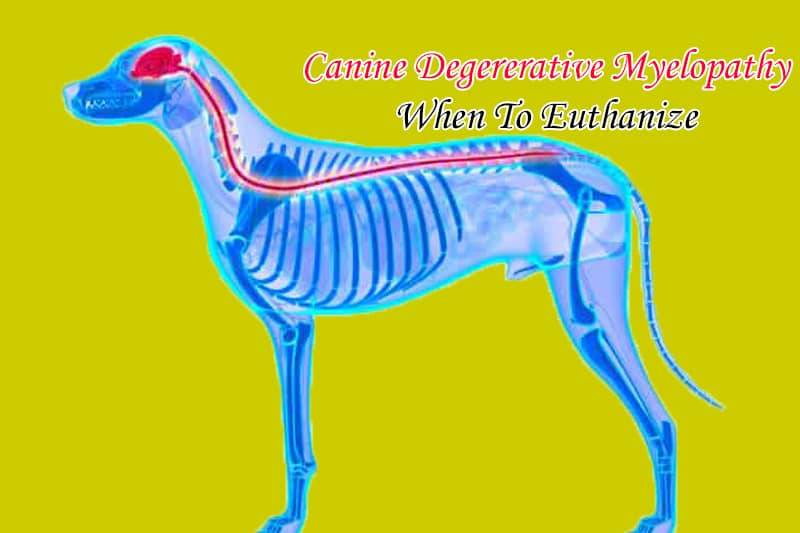Dogs are the most joyous creature and their presence is enough to brighten up the day. As a dog parent, I can vouch for the fact that there is no worse feeling than to bid farewell to your fur baby, your best friend.
However, there are times in life when you need to that step so that they can rest peacefully. The decision is absolutely nerve-wracking but sometimes it is the right thing to do.
Dogs suffer from tons of different diseases and degenerative myelopathy is one of the most complex conditions. Sadly, the dog needs to be put down in 6-months to end its suffering. Euthanizing a dog with such a condition can be extremely difficult. Make sure you consult with the vet to ensure this is the best before going ahead with the process.
What is Degenerative Myelopathy in Canine?
Degenerative Myelopathy (DM) is also known as a chronic degenerative syndrome (CDRM). This disease affects the spinal cord which eventually results in hind limb weakness and paralysis. We do not know the exact cause of the disease; however, it generally causes due to the degeneration of the white matter in the spinal cord. The disease generally occurs in older dogs typically between 8 to 14 years of age.
What are the Causes of Degenerative Myelopathy?
There no certain cause for the disease, however, there are a couple of factors that are responsible.
Breed
It is a common misconception among people that this disease only affects German Shepherds. Even the condition is also known as ‘German Shepherd Disease” initially. Recent studies have shown that it can happen across different breeds, however, some specific dog breeds like German Shepherd, Golden Retriever, Burmese Mountain Dog, Corgi, Pug, and Puddle possess more risk.
Genetics
Degenerative myelopathy is a genetically inherited disease and it is one of the primary reasons for developing it. If you are getting a dog from a shelter or breeder then it is very important that you ask whether the dog’s parents had any medical condition like this. SOD1 mutation is the specific gene responsible for the disease. If any of the parents is the carrier then it puts them at risk as well.
Age
The health condition is more prominent in senior dogs. Senior dogs tend to suffer from arthritis and similar age-related disease which makes it harder to diagnose degenerative myelopathy. Typically, dogs between 6 to 4 years of age are more prone to catch the disease.
Which Symptoms will Show that it’s Time?
Saying goodbye to your dog is never easy and it will be one of the most excruciating feelings you will be experiencing in your life. The dogs will show several symptoms and signs which will show that it is time to bid adieu.
Mobility is one of the clear signs that will indicate the severity of the disease. The dog will eventually lose its ability to do the simplest task like getting up or going outside for potty breaks. It will no longer be able to play or go for walks.
Studies have shown that degenerative myelopathy does not cause pain. However, the mobility challenges can cause pain and affect the regular lifestyle. It can have sore muscles for sitting in the same position for too long.
Due to old age, the dog can also generate other diseases like arthritis which will make it more difficult for the dog to get up from his bed. The combination of different diseases can aggravate the pain and level of suffering.
Finding the Right Time to Euthanize the Dog?
Euthanizing your dog may be one of the hardest decisions you have to take. Sadly, there is no cure for degenerative myelopathy as it is progressive. After the diagnosis period, the dog may live for 6 to 12 months depending on its health condition and mild treatment. However, you can at best have a 3-years life expectancy under severe treatment.
Now the question is, should you let the dog go through the sufferings and pains to keep him a little longer with you? You should ask yourself whether the dog is enjoying his life and weigh out if this the way to live his life.
Canine Degenerative Myelopathy When to Euthanize?
If the dog is physically fit then there is no need to euthanize. However, if the dog is severely ill, depressed, and has reached rock bottom, then it is time to go for the process. Make sure you discuss with the vet to get some expert opinion whether it is the right time to put him to sleep.
We do want to keep our fur babies with us for as long as possible which lead us to delay the euthanizing process. As time passes by, the condition only worsens causing immense pain to the dog. You will eventually realize that you should have taken the decision much earlier.
FAQs
Degenerative myelopathy may seem like a painful condition but studies have shown that it is not that painful. The condition has different stages and the level of pain will vary depending on the stage the dog is in.
Dogs suffering from degenerative myelopathy may live from 6 months to 3 years depending on the severity of the disease and health care.
Diagnosing degenerative myelopathy is a stringent process. The only way to confirm is to perform an autopsy/necropsy on a deceased dog. However, vets run some common tests like x-rays, blood tests, CT scans, myelograms, and MRI to diagnose the disease. These test results help to rule out the possibilities of other diseases and help to diagnose DM.
Final Thoughts
Euthanizing your pet is an extremely hard and personal decision. You may never be mentally ready for it but it may be the only decision that will take away the dog’s pain and suffering. The disease progress through different stages and the symptoms become severe with each passing day.
We hope that all our dogs are having tons of fun and treat down the rainbow bridge. Love and cuddles for all fur babies out there.

